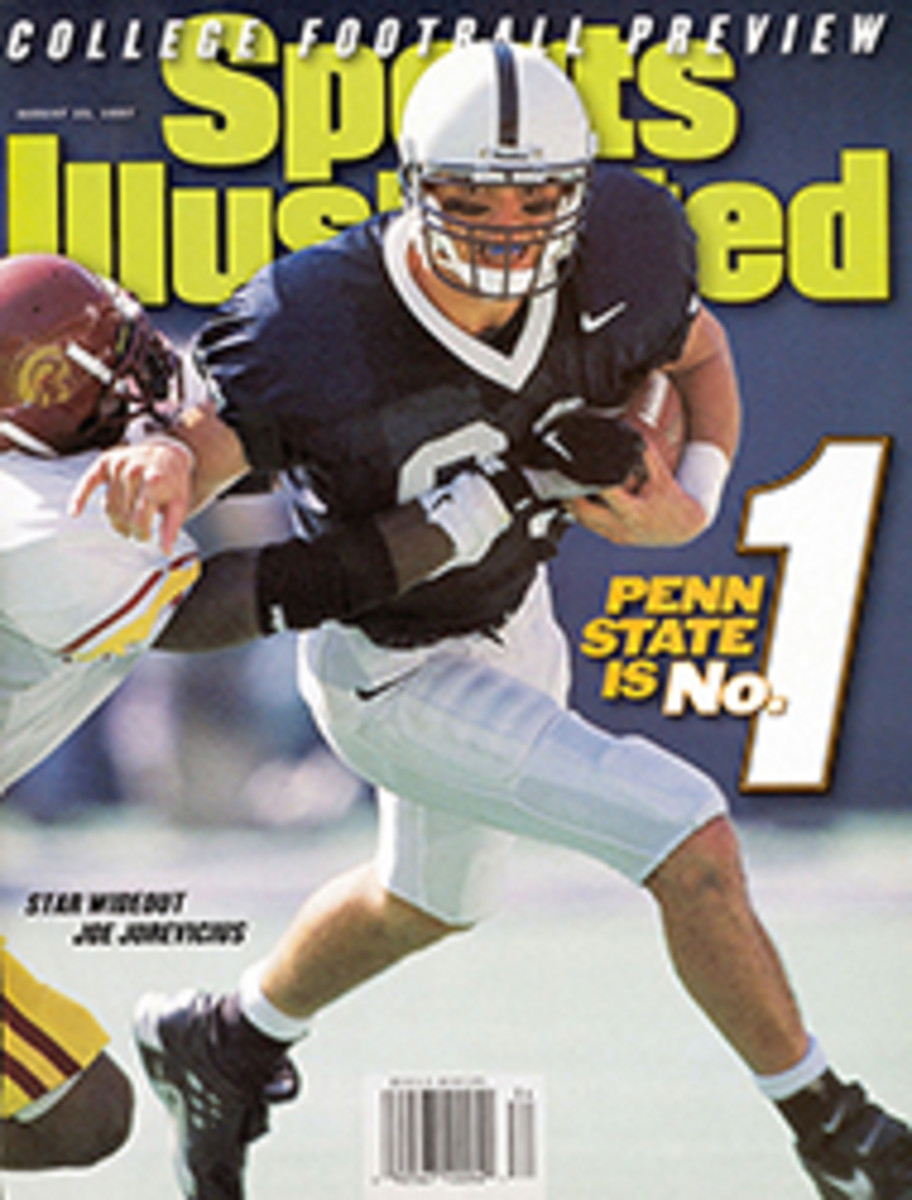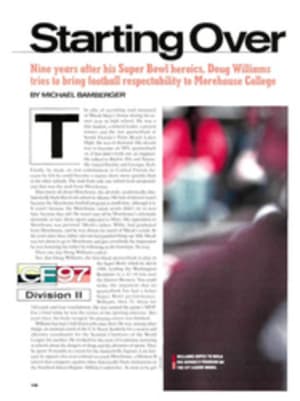
HOMETOWN HEROES THE FIRST LITTLE LEAGUE WORLD SERIES, IN 1947, WAS WON BY WILLIAMSPORT'S OWN
The photo could not be more evocative. A group of tousle-haired
boys and their two coaches pose with a trophy proclaiming them
kid baseball champions of the known universe. It is August 1947,
and the boys are from the blue-collar Maynard section of
Williamsport, Pa. They stand and kneel, hot and weary, having
just become the first Little League World Series champions.
About 2,500 people went to Original Field in Williamsport to see
the Maynard Midgets annihilate a team from nearby Lock Haven
16-7 in the championship game. It took temerity to call this
first event a World Series, since all but one of the teams were
from Pennsylvania. But within 15 years teams from the U.S.,
Canada, Mexico, Europe and Asia would come to Williamsport to
vie for baseball glory. Now the Little League World Series is
televised globally, and this year's championship, which will
take place from Aug. 17 to Aug. 23, marks the golden anniversary
of what started as virtually a hometown affair.
Fifty years after the initial World Series, those first
champions, now retired or soon to be so, remember the event as
having been both little and big. "After winning the semifinal,
we went across the street to Bowman Field, where the
Williamsport minor league team played," says Ed Jonas, 61, a
Maynard outfielder then and a farmer in northeastern
Pennsylvania today. "We were able to have chocolate milk and
peanut-butter sandwiches in the clubhouse. I said it couldn't
get any better than this."
"The championship came up rather suddenly," says Don Stover, 62,
who pitched 10 innings in 90[degree] afternoon heat to win the
semifinal for Maynard 2-1 over the Lincoln League of Newberry,
Pa. "We won in the afternoon and then in the evening, and it was
over. But I remember it vividly. I'm sure we all do. We were all
such good friends."
One thing that makes the Maynard championship photo remarkable
is that two of the youngsters in it are African-American. Lou
(Scrap Iron) Baity wears his cap jauntily off to the side and
folds his arms confidently. Kneeling in the front row is Walt
Dunston.
"Color?" says Baity, now 63 and working as an inventor in
Inglewood, Calif., after a panoply of jobs in the entertainment
industry. "Nobody ever thought about that. They had an attitude
in Williamsport that was pretty straightaway."
"Back in those days you picked the best, regardless," says
Dunston, 62, a dentist with a practice in Philadelphia. "The
best is what they put on the field in Williamsport." Yet Dunston
knew that the Phillies had made racist remarks to Jackie
Robinson that same year, in Robinson's rookie season. "We were
aware that Robinson was the first black ballplayer," Dunston
says. "We were aware why there weren't other African-American
ballplayers, even though we weren't shown prejudice in our city.
We were trained with our friends that if you did well in school
and got an education, you could make an income and buy a home
wherever you wanted. Unfortunately, you got out and found out
[other] places weren't like Williamsport."
In fact, Little League had a decent early record on race,
especially when compared with the slow pace of integration in
the major leagues. Three of the five World Series champions
after Maynard were integrated teams from New Jersey and
Connecticut. In 1955 white teams in South Carolina refused to
play a black squad from Charleston, so Little League declared
that state's championship vacant and invited the black
Charleston team to the World Series as honorary, though
nonplaying, South Carolina champs.
The white players on the '47 Maynard team seem shocked when they
are asked about racism. "Jeez, who thought anything about it?"
says Stover. "We grew up integrated and had all sorts of ethnic
groups: Italian, Irish, Polish, German. We were in each other's
houses, and everybody's mother yelled at every kid."
"We were like brothers," says Rusty Columbine, 62, then the
Midgets' rightfielder. "We were all poor. There was no time for
prejudice."
Carm Grieco, one of the Lock Haven players who opposed Maynard
in the finals, moved into the Maynard neighborhood that summer,
when his father opened a pharmacy in Williamsport. "There were
no blacks in Lock Haven, but when I got to Williamsport, they
all took me in," says Grieco, now 62, who remembers being given
16 round-trip bus tickets by the coaches in Lock Haven so he
could continue to play for them after his family's move. "Walt
Dunston was one of my greatest friends," Grieco continues. "I
never knew racism [in Williamsport]. Maybe it was a different
time, but we just didn't know from that stuff."
In fact, Dunston was probably from the most prosperous family
among his Maynard teammates. His father was a dentist. Several
of his teammates, including Columbine, grew up without fathers
at home, and most of the others' dads worked in the factories
that lined the Susquehanna River. Maynard was literally on the
wrong side of the tracks for Little League. The early
Williamsport teams set the boundaries from which they accepted
boys at the railroad tracks near Maynard Street.
In the spring of 1947, Bethlehem Steel, which had a wire-rope
plant in Williamsport, donated land for construction of a ball
field. Little League had started in Williamsport in 1939, and
after World War II ended, as more towns organized teams, local
people thought of staging a "national" championship. "We used to
ride our bikes over there every day to see how [the field] was
coming along," says Jack Losch, 61, generally considered the
best athlete among the Midgets. Losch was a star halfback in
football and went to the University of Miami on a football
scholarship. In 1956 he was drafted in the first round by the
Green Bay Packers. His career, however, was short. After his
first pro season he served three years in the Air Force as part
of his ROTC requirement. When he returned to the Packers he
discovered that an old kidney infection had caused
calcification, and he had to retire.
"We didn't have a car," says Losch, a centerfielder whose
10th-inning double won the semifinal game for the Midgets in
1947. "We didn't have a phone. But when my dad came home from
work at the factory at 3:15, we would play catch for an hour
before dinner. It sounds funny today, but you just appreciated
what you had." Losch went to work for General Motors, retiring,
after 32 years, as manager of sales for the fleet division of
Pontiac. Last year he moved back to Williamsport.
The tidy stadium at Original Field, where the team from Maynard
won its championship, is still used. But the facility is
minuscule compared with Lamade Stadium, the huge complex across
town at Little League headquarters where the Series is now
played before nearly 40,000 fans and a worldwide TV audience.
There were no satellite feeds in 1947, when Maynard blew out
Lock Haven early, getting a 9-2 lead in the second inning and
coasting to victory. The 16 runs the Midgets eventually scored
was a championship record until the Hua Lian team from Taiwan
scored 21 in 1987. Midgets third baseman Tony Ingersol went 4
for 4 in the Lock Haven game, giving him a .625 average for the
four-game World Series, a record that stood for nearly 40 years.
The Maynard team batted .418.
"I picked 14 kids who could hit," says Charlie Scudder, 80, who
managed the Midgets with his buddy Harry Berry, though neither
man had a son on the team. (Scudder's son, Charles Jr., managed
current Little League Baseball Inc. president Steve Keener when
Keener played Little League in the 1960s.) "I saw too many teams
that couldn't hit. Most of the time we just practiced hitting. I
didn't care how many runs the other team could score. I could
score more.
"Harry and I worked the third shift at Bethlehem Steel. I got
home at 7 a.m., and I either napped for a while or stayed up
until the games started. I made them toe the mark. They had to
be someplace at a certain time to practice, and they were there.
All of them were really good boys."
"I think we thought anything was possible after that win," says
Bill Gallagher, 61, who nearly blacked out after catching 10
innings for the Midgets in the semifinal game and the first four
of the final. "Things were moving ahead, and prosperity was
starting in the U.S. again. It was the beginning of a big boom,
and kids were definitely a big part of it. I think we were a
sign that organized leagues for kids were going to become a
thing of the future."
Nearly all the Midgets went on to college; most of them were the
first in their families to do so. Some excelled in sports. But
all seemed to grow from that hot, sweaty August day. "You know
what I'm most proud of?" says Ingersol, whose dad died when he
was five. "Having that batting record was nice, and winning the
championship was nice too. But every one of us accomplished
something later. We all had the drive to do something more after
we realized we were winners. We came from very little and were
winners then, and all our lives."
Robert Strauss is a freelance writer who lives in Haddonfield,
N.J.
B/W PHOTO: COURTESY OF LITTLE LEAGUE BASEBALL INC. The year Robinson broke into the majors, Dunston (kneeling, third from right) and Baity (standing, left) played for victorious Maynard. [Maynard Little League baseball team]
COLOR PHOTO: GABE PALACIO Original Field is still around and so are former Midgets (from left) Losch, Scudder and Jimmy Sughrue. [Jack Losch, Charlie Scudder and Jimmy Sughrue]

